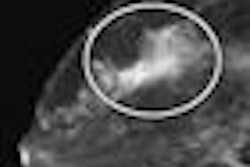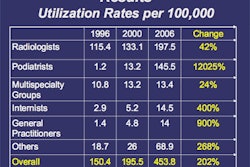Ultrasound elastography may be useful as an adjunct for the challenging task of evaluating thyroid nodules, according to a pair of recent studies.
In the first study, a multicenter trial concluded that combining elastography with grayscale ultrasound and color Doppler offers the potential of improving the characterization of thyroid nodules. Meanwhile, a separate Korean study also determined that elastography was useful in providing differential diagnosis of indeterminate thyroid nodules.
"We've got a ways to go, but I think there's promise on the horizon for this rather vexing topic," said Dr. Rick Feld of Thomas Jefferson University (TJU) in Philadelphia. He presented the research during a talk at the 2008 RSNA meeting in Chicago.
Seeking to determine if the combination of the three ultrasound techniques could improve the characterization of thyroid nodules as benign or malignant, a research team led by Feld studied 100 nodules from patients scheduled for fine-needle biopsy or surgery of a suspicious thyroid nodule. Fifty nodules were contributed by TJU, while fifty were from a Japanese institution. Of the 100 nodules, pathology indicated that 81 were benign and 19 were malignant.
All three ultrasound techniques were performed using an EUB-8500 ultrasound scanner (Hitachi Medical, Tokyo). Still images and video from each examination were digitally recorded and interpreted by four independent, experienced, and blinded readers.
The readers rated each nodule in random order on a five-point scale ranging from definitely benign to definitely malignant. The accuracy of each reader was measured first based on their use of each ultrasound mode alone, then on a combination of all three, according to Feld.
In the combination analysis, two readers were more accurate than a third reader using all three modes (p < 0.01).
In analyzing the data by reader, one reader achieved their highest accuracy with elastography (77%) among the individual modes as well as with all three modes combined (83%), Feld said.
In analyzing the data by mode, one reader achieved the highest accuracy with color Doppler (90%), a difference that was statistically significant (p < 0.002). One reader was more accurate than the other readers in grayscale (89%) (p = 0.002), while three readers were more accurate than the fourth in elastography (p < 0.05).
In examining reader variability, elastography produced the highest intraclass coefficient (0.44-0.63), representing a higher level of agreement among readers. Color Doppler had the lowest level of reader agreement (intraclass coefficient of 0.22-0.48), while grayscale ultrasound occupied the middle ground (intraclass coefficient of 0.32-0.53).
"There is interobserver variability in all three [methods], but it turns out that elastography did the best of all three," Feld said. "With all three combined, [interobserver variability was lower] than each of the three alone."
More research is warranted to determine the ultimate clinical utility of elastography when used in combination with other modalities, he said.
In a related presentation at the 2008 RSNA meeting, researchers from Hanyang University Hospital in Seoul, South Korea, found ultrasound elastography to be useful as an adjunctive method for categorizing indeterminate thyroid nodules.
The Hanyang research team prospectively studied 56 consecutive patients with 78 thyroid nodules (61 benign, 17 malignant) between October 2007 and January 2008. All patients were scheduled to undergo thyroidectomy and had indeterminate findings on conventional ultrasound.
Indeterminate findings included no malignant signs (taller shape, spiculated margin, calcification except rim type, and markedly hypoechoic) and the lack of definitely benign signs (cyst or predominantly cystic nodule), according to presenter Dr. Jeong-Seon Park.
Elasticity images were obtained with light compression, and an elasticity (E) score was calculated based on the Tsukuba Elasticity Score of 1 to 5 according to the degree and distribution of tissue strain, Park said. The proportion of no strain (PNS) was also assessed.
The researchers then examined the mean E scores and PNS in benign and malignant nodules using a Student's t-test. The technique's ability to differentiate malignant from benign nodules was evaluated utilizing a receiver operator characteristics (ROC) analysis to compare the area under the curve (AUC), sensitivity, specificity, and accuracy, according to Park.
|
The differences in mean E score and mean PNS were statistically significant (p < 0.001). The AUC was 0.814 for E score and 0.884 for PNS. The researchers found no statistically significant difference in the AUC between E score and PNS (p = 0.143).
The E score between 2 and 3 led to a sensitivity of 70.6%, specificity of 85.2%, and accuracy of 76%, according to the researchers. Analyzing lesions using the PNS measurement yielded a sensitivity of 70.6%, specificity of 85.2%, and accuracy of 78.2%
"Although thyroid nodules had indeterminate findings in conventional ultrasound, the elasticity was significantly different between malignant and benign nodules," Park said.
By Erik L. Ridley
AuntMinnie.com staff writer
February 11, 2009
Related Reading
Screening for thyroid cancer worthwhile in some childhood cancer survivors, December 29, 2008
Ultrasound's accuracy in differentiating thyroid nodules depends on nodule size, June 11, 2008
Ultrasound helps spot malignant thyroid nodules, September 12, 2007
Thyroid nodule shape on ultrasound proves to be strong malignancy indicator, April 13, 2007
Rising thyroid cancer rates in U.S. due to increased detection, May 10, 2006
Copyright © 2009 AuntMinnie.com




















